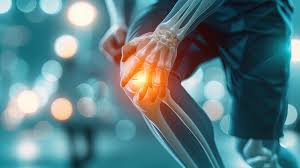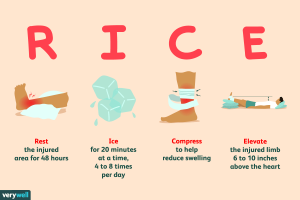Exercise stands as a cornerstone of a healthy lifestyle, offering a multitude of benefits that span physical, mental, and emotional well-being. From strength training to cardio workouts and everything in between, engaging in regular physical activity is celebrated for its ability to boost mood, improve cardiovascular health, enhance muscle tone, and even reduce the risk of chronic diseases. However, even the most dedicated and enthusiastic athletes can find themselves facing a common adversary on their fitness journey: injury.

In the pursuit of progress and the desire to reach new heights, athletes and fitness enthusiasts often push their limits, testing the boundaries of their physical capabilities. This drive to excel, while admirable, can sometimes lead to overuse injuries, strains, sprains, and other exercise-related ailments. Whether you’re a seasoned athlete or a beginner embarking on your fitness quest, understanding the nuances of exercise-related injuries is crucial.
Managing and overcoming these setbacks requires not only knowledge of injury prevention techniques but also a thorough understanding of how to recognize the signs and symptoms of common exercise-related injuries. By arming yourself with this knowledge, you can navigate the path to recovery with confidence and efficiency, ensuring that you get back to your fitness routine safely and with minimal interruptions.
In this guide, we’ll delve into the world of exercise-related injuries, exploring the most common types, their causes, symptoms, and most importantly, effective strategies for prevention and rehabilitation. Whether you’re grappling with a nagging ache or seeking proactive measures to safeguard against future injuries, this resource aims to be your trusted companion in conquering the climb to optimal health and fitness. We’ll explore:
Types of Exercise Injuries: Recognizing the Red Flags
Exercise injuries can present themselves in a variety of forms, each with its unique characteristics and challenges. Understanding these different types is crucial for effective treatment and management. Exercise injuries are broadly categorized into two main types: acute injuries and overuse injuries.
Acute Injuries:
Acute injuries are sudden and typically occur as a result of a specific event or trauma. These injuries often manifest immediately or shortly after the inciting incident. Common examples of acute injuries include:
Sprains: An injury to a ligament, which connects bones to each other. Sprains often occur in joints such as the ankle, knee, or wrist and can range from mild to severe, depending on the extent of ligament damage.
Strains: Strains involve the stretching or tearing of a muscle or tendon. They can occur in various parts of the body, such as the hamstring, calf, or shoulder muscles.
Fractures: A fracture is a break or crack in a bone, often caused by a sudden impact or excessive force. Fractures can range from hairline fractures to complete breaks and require immediate medical attention.
Dislocations: A dislocation occurs when a bone is forced out of its normal position within a joint. This can lead to severe pain, swelling, and immobility of the affected joint.
Acute injuries are characterized by their sudden onset, often accompanied by immediate pain, swelling, bruising, and loss of function in the affected area. Individuals may also experience difficulty bearing weight or moving the injured limb or joint.
Overuse Injuries:
Unlike acute injuries, overuse injuries develop gradually over time due to repetitive stress on a particular body part. These injuries are often the result of prolonged or repetitive activities without adequate rest or recovery. Common examples of overuse injuries include:
Tendinitis: Inflammation or irritation of a tendon, which connects muscle to bone. Tendinitis commonly affects areas such as the Achilles tendon, rotator cuff, or elbow tendons (as in tennis elbow).
Bursitis: Inflammation of the bursae, small fluid-filled sacs that cushion and lubricate joints. Bursitis often occurs in areas subject to repetitive motion, such as the shoulder, hip, or knee.
Stress Fractures: Microscopic cracks or fractures in bones, typically caused by repetitive impact or excessive training. Stress fractures commonly affect weight-bearing bones such as the shin (shin splints) or foot bones.
Muscle Imbalances: When certain muscles become overdeveloped or stronger than their opposing muscles, it can lead to imbalances in movement patterns and increased risk of injury. Imbalances often result from repetitive use of certain muscles while neglecting others.
Overuse injuries tend to start as mild discomfort or stiffness that worsens over time with continued activity. Individuals may notice a gradual onset of pain, tenderness, swelling, or aching in the affected area, especially during or after exercise.
Common Injury Sites and Symptoms:
Lower Body:
Knee Injuries: Common knee injuries include patellar tendinitis (inflammation of the patellar tendon), meniscus tears, and ligament sprains (such as ACL or MCL injuries). Symptoms may include swelling, instability, pain with bending or straightening the knee, and difficulty bearing weight.
Ankle Sprains: Ankle sprains occur when the ligaments surrounding the ankle joint are stretched or torn, often due to a sudden twisting motion. Symptoms include swelling, bruising, pain with weight-bearing, and difficulty walking.
Shin Splints: Medial tibial stress syndrome, commonly known as shin splints, is an overuse injury that causes pain along the inner edge of the shinbone (tibia). Symptoms include sharp or dull pain along the shin, especially during or after exercise.
Plantar Fasciitis: Inflammation of the plantar fascia, a thick band of tissue that runs along the bottom of the foot. Plantar fasciitis causes heel pain, especially with the first steps in the morning or after prolonged periods of rest.
Upper Body:
Rotator Cuff Injuries: The rotator cuff is a group of muscles and tendons that stabilize the shoulder joint. Injuries to the rotator cuff can cause pain, weakness, and limited range of motion, particularly with overhead activities.
Tennis Elbow (Lateral Epicondylitis): An overuse injury that affects the tendons on the outside of the elbow. Tennis elbow causes pain and tenderness on the outer part of the elbow, often aggravated by gripping or lifting objects.
Wrist Sprains: Sprains of the wrist ligaments can occur due to falls, sudden impacts, or repetitive stress. Symptoms include pain, swelling, stiffness, and difficulty moving the wrist.
Core:
Lower Back Pain: A common complaint among athletes, lower back pain can result from muscle strains, herniated discs, or poor posture. Symptoms may include stiffness, shooting pain down the legs (sciatica), and difficulty standing or sitting for prolonged periods.
Hip Strains: Strains of the hip muscles or tendons can occur due to sudden movements, overuse, or inadequate warm-up. Symptoms include pain in the hip or groin area, limited range of motion, and difficulty walking or climbing stairs.
Recognizing the early signs and symptoms of exercise-related injuries is crucial for prompt treatment and prevention of further damage. Individuals experiencing persistent or worsening pain, swelling, weakness, or loss of function in any part of the body should seek medical evaluation and guidance.
By understanding the distinctions between acute and overuse injuries, along with the common sites and symptoms of exercise-related ailments, individuals can take proactive steps to address potential issues and maintain a safe, effective fitness routine.
The RICE Method: Your First Response Kit
When faced with an exercise-related injury, the RICE method serves as an invaluable first aid toolkit to mitigate pain and inflammation:

Rest:
Immediately cease the activity causing pain and rest the injured area. Avoid placing weight or strain on the affected limb or joint to prevent further damage.
Ice:
Apply an ice pack wrapped in a cloth or towel to the injured area for 15-20 minutes at a time, several times a day. Ice helps reduce swelling, inflammation, and numbs the area to alleviate pain.
Compression:
Use a gentle compression bandage to provide support and reduce swelling. Ensure the bandage is snug but not too tight to impede circulation.
Elevation:
Elevate the injured limb or joint above the level of the heart whenever possible. This helps reduce swelling by promoting drainage of excess fluid.
Seeking Medical Attention: When to Consult a Doctor
While the RICE method can effectively manage many minor exercise injuries, certain situations warrant professional medical evaluation:
- Severe pain that does not improve with rest and home care.
- Significant swelling, bruising, or deformity around the injured area.
- Numbness, tingling, or weakness that persists or worsens.
- Suspected fractures, dislocations, or other serious injuries.
Prompt evaluation by a healthcare professional ensures an accurate diagnosis and appropriate treatment plan to facilitate optimal recovery.
Treatment and Rehabilitation: Mending Your Body
Recovering from an exercise-related injury is a journey that often requires a comprehensive and tailored approach. The goal of treatment and rehabilitation is not only to alleviate pain and restore function but also to prevent future recurrences. Here’s a closer look at the key components of the recovery process:
Rest and Immobilization:
One of the initial steps in treating many exercise injuries is allowing the affected area time to heal through rest and immobilization. This may involve the use of:
Slings: For injuries to the shoulder, arm, or elbow, a sling can help immobilize the joint and prevent excessive movement.
Braces: Joint braces or supports are commonly used to provide stability and limit motion in injured joints such as the knee, ankle, or wrist.
Casts: In the case of fractures or severe sprains, a cast may be applied to immobilize the affected limb and promote proper healing.
Resting the injured area reduces further stress on damaged tissues, allowing the body’s natural healing processes to take place. It’s crucial to follow a healthcare provider’s recommendations regarding the duration and extent of rest needed for optimal recovery.
Physical Therapy:
A structured physical therapy program is a cornerstone of rehabilitation for many exercise injuries. Physical therapists play a vital role in guiding individuals through exercises, stretches, and modalities aimed at:
Restoring Strength: Targeted exercises help rebuild muscle strength in the injured area, improving stability and function.
Improving Flexibility: Gentle stretches and range-of-motion exercises prevent stiffness and promote flexibility in joints and muscles.
Enhancing Proprioception: Proprioception refers to the body’s ability to sense its position in space. Balance and coordination exercises help improve proprioception, reducing the risk of re-injury.
Functional Training: Therapy often includes functional movements and activities specific to the individual’s daily tasks or sports activities. This helps transition from rehabilitation to full activity safely.
Physical therapists tailor treatment plans to each individual’s needs, adjusting exercises and techniques as the injury progresses. The goal is not only to recover from the current injury but also to strengthen and stabilize the body to prevent future injuries.
Medication and Pain Management:

Pain and inflammation are common companions of exercise injuries, and managing these symptoms is an essential aspect of recovery. Depending on the severity of pain, healthcare providers may recommend:
Over-the-Counter Medications: Nonsteroidal anti-inflammatory drugs (NSAIDs) such as ibuprofen or acetaminophen can help reduce pain and inflammation. These medications are typically used for short-term relief and should be taken as directed.
Corticosteroid Injections: In cases of significant inflammation or persistent pain, corticosteroid injections may be administered directly into the affected area. These injections provide targeted relief by reducing inflammation and swelling.
It’s important to follow a healthcare provider’s instructions regarding medication usage, as misuse or overuse can have adverse effects on the body.
Surgical Intervention:
For severe exercise injuries, especially those involving torn ligaments, fractures requiring stabilization, or extensive joint damage, surgical intervention may be necessary. Common surgical procedures for exercise injuries include:
Ligament Repair: Surgery to repair torn ligaments, such as the ACL (anterior cruciate ligament) in the knee or the rotator cuff in the shoulder.
Fracture Fixation: Procedures to align and stabilize broken bones using pins, screws, plates, or rods.
Joint Replacement: In cases of advanced joint damage, such as severe osteoarthritis, joint replacement surgery may be recommended to restore function and alleviate pain.
Surgical interventions aim to repair damaged tissues, restore stability and function, and facilitate a full return to activity. Post-surgery rehabilitation often includes physical therapy to regain strength, mobility, and function in the affected area.
Recovery and Beyond:
The journey to recovery from an exercise injury is not just about treating the immediate issue—it’s also about building resilience and preventing future injuries. As individuals progress through rehabilitation, they learn valuable lessons about proper body mechanics, injury prevention strategies, and self-care practices.
Maintaining an active role in recovery, such as performing prescribed exercises, attending physical therapy sessions, and following a healthy lifestyle, is crucial for long-term success. Additionally, individuals are encouraged to:
Gradually Return to Activity: Rushing back into full activity too soon can lead to re-injury. Healthcare providers often provide guidelines for a gradual return to exercise, starting with low-impact activities and gradually increasing intensity.
Practice Good Body Mechanics: Learning proper form and technique during exercises and daily activities can reduce the risk of future injuries. This includes using appropriate equipment, lifting techniques, and posture awareness.
Stay Consistent with Home Exercises: Continuing with prescribed home exercises and stretches helps maintain strength, flexibility, and function even after formal rehabilitation ends.
Listen to Your Body: Paying attention to any signs of discomfort or pain during exercise is essential. It’s okay to modify activities or seek guidance if something doesn’t feel right.
Through dedication to the rehabilitation process, a focus on injury prevention, and a commitment to overall health and wellness, individuals can emerge from exercise injuries stronger, more resilient, and better equipped to enjoy a full and active life.
Prevention Strategies: Building a Fortress Against Injury
Preventing exercise-related injuries is a proactive endeavor that begins with adopting smart practices and habits:
Warm-up and Cool-down:
Prioritize dynamic stretches and light aerobic activity to prepare your muscles and joints for exercise. Cool down with static stretches to aid in muscle recovery and flexibility.
Listen to Your Body:
Pain is your body’s way of signaling that something is amiss. Respect pain signals and avoid pushing through discomfort, as this can exacerbate existing injuries.
Proper Technique and Form:
Whether lifting weights, running, or performing yoga poses, correct form is essential. Improper technique can lead to undue stress on joints, muscles, and ligaments.
Gradual Progression:
Avoid the temptation to jump into intense workouts without proper conditioning. Gradually increase the intensity, duration, and frequency of your exercise regimen to allow your body to adapt.
Strength and Stability Training:
Incorporate strength training exercises that target major muscle groups and promote joint stability. Strong muscles act as protective armor against injury.
Appropriate Gear and Equipment:
Invest in quality footwear, supportive braces, and protective gear suited to your activity of choice. Ill-fitting or worn-out gear can contribute to injury.
Hydration and Nutrition:
Maintain proper hydration before, during, and after exercise to support optimal muscle function and tissue repair. A balanced diet rich in nutrients fuels your body’s healing process
Consistent Effort, Smart Practices: Your Fitness Journey
Embarking on a fitness journey is a commitment to your health and well-being. By arming yourself with knowledge, adopting preventive measures, and listening to your body’s cues, you can navigate the world of exercise with confidence.
Remember, the road to recovery from an injury is a journey in itself, requiring patience, dedication, and perseverance. Consultation with a certified personal trainer, physical therapist, or sports medicine specialist can provide personalized guidance and support along the way.
Incorporating low-impact activities such as swimming, yoga, or Pilates into your routine can maintain fitness levels while allowing injured areas to heal. Additionally, prioritize self-care practices such as adequate sleep, stress management, and regular check-ins with healthcare providers.
As you conquer the climb towards optimal health and fitness, know that each setback presents an opportunity for growth and learning. By embracing preventive measures and adopting a holistic approach to wellness, you’ll forge a path towards a stronger, resilient, and more vibrant you.
